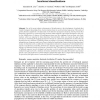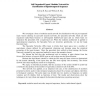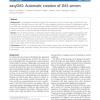282 search results - page 22 / 57 » Active Clustering of Biological Sequences |
ICRA
2007
IEEE
14 years 2 months ago
2007
IEEE
Abstract— This paper presents a method for detecting independent temporally-persistent motion patterns in image sequences. The result is a description of the dynamic content of a...
BMCBI
2010
13 years 7 months ago
2010
Background: Detection of common evolutionary origin (homology) is a primary means of inferring protein structure and function. At present, comparison of protein families represent...
BMCBI
2005
13 years 7 months ago
2005
: One of the most evident achievements of bioinformatics is the development of methods that transfer biological knowledge from characterised proteins to uncharacterised sequences. ...
IDA
1998
Springer
13 years 7 months ago
1998
Springer
We investigate a form of modular neural network for classification with (a) pre-separated input vectors entering its specialist (expert) networks, (b) specialist networks which ar...
BMCBI
2011
13 years 2 months ago
2011
Background: The Distributed Annotation System (DAS) has proven to be a successful way to publish and share biological data. Although there are more than 750 active registered serv...



